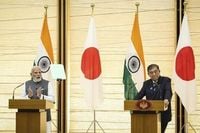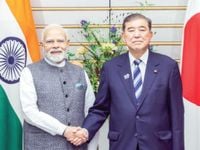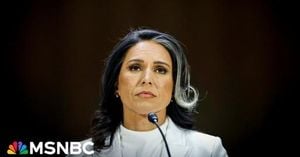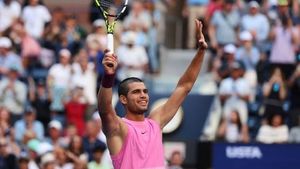Prime Minister Narendra Modi’s recent visit to Japan has set the stage for what officials on both sides are calling a new era of strategic and economic partnership between India and Japan. Over the course of a packed two-day visit in late August 2025, Modi and Japanese Prime Minister Shigeru Ishiba unveiled a sweeping roadmap that is expected to shape the bilateral relationship for the next decade. The visit, marked by symbolism and substance alike, saw a flurry of agreements, major investment pledges, and a shared vision for navigating the shifting dynamics of the Indo-Pacific region.
According to The Sunday Guardian, Modi was received with full ceremonial honors by Ishiba, and the two leaders spent most of the visit together, underscoring the close personal rapport that has come to define current India-Japan ties. In a gesture that highlighted the warmth of the relationship, Ishiba accompanied Modi on the iconic Shinkansen bullet train from Tokyo to Sendai, where the leaders shared a meal and later toured a chip-making equipment manufacturer’s plant in Miyagi Prefecture. Ishiba took the opportunity to showcase the train’s safety and punctuality—a not-so-subtle nod to the high-speed rail ambitions now taking root in India.
The high-speed rail project, specifically the Mumbai-Ahmedabad corridor, featured prominently in the leaders’ discussions. Both sides pledged to work towards the commencement of operations on this line, with the introduction of Shinkansen technology seen as a flagship symbol of the partnership. As reported by NHK, Ishiba described Modi’s visit as “very fruitful,” emphasizing the significance of bilateral collaboration not just in Asia, but also in the Pacific and Africa.
But the visit was about far more than trains. The most headline-grabbing announcement came with Japan’s commitment of JPY 10 trillion in private investment into India over the next decade—a figure that dwarfs previous levels and signals strong confidence in India’s economic prospects. According to The Sunday Guardian, this investment pledge was unveiled alongside the India-Japan Joint Vision for the Next Decade, a comprehensive framework that covers economic growth, technology, security, innovation, sustainability, health, clean energy, mobility, and cultural exchanges.
“From Metro to manufacturing, from semiconductors to start-ups, India-Japan partnership in every sector became symbol of mutual trust,” Modi declared at the India-Japan Joint Economic Forum in Tokyo, as quoted by The Independent. At a joint press conference, he added, “We believe that Japanese technology and Indian talent are a winning combination.” This sentiment was echoed by Ishiba, who told reporters, “Japan’s advanced technology and India’s outstanding talent, as well as its large market, are complementing each other to a dramatic expansion of our economic ties.”
One of the most pressing issues on Japan’s domestic agenda—its rapidly aging and shrinking population—was also front and center. New figures released by the Japanese government in August 2025 revealed that the number of Japanese nationals fell by over 900,000 in the previous year, with record-low births and a declining working-age population. Nearly one in three Japanese citizens is now aged 65 or older. To help address these labor shortages, Modi and Ishiba agreed to facilitate the exchange of 500,000 people—including workers and students—between the two countries over the next five years. “We need to have to take advantage of each other’s strengths, to bring solutions to our challenges and to help each other,” Ishiba said, according to AP.
The semiconductor sector emerged as another key pillar of cooperation. During their visit to Sendai, the leaders highlighted the complementarity between India’s growing semiconductor manufacturing ecosystem and Japan’s strengths in advanced semiconductor equipment and technology. Both sides reaffirmed their commitment to deepening cooperation in this sector, building on the Memorandum of Cooperation on the Japan-India Semiconductor Supply Chain Partnership and ongoing collaborations under the India-Japan Industrial Competitiveness Partnership and Economic Security Dialogue, as highlighted by the Indian government’s official statement. Modi was clear: “Semiconductors and rare earth minerals will be at the top of our agenda.”
Beyond economics and technology, the two leaders used the occasion to reaffirm their countries’ shared commitment to democracy and the rule of law. They released a joint vision for cooperation over the next decade in areas such as security, defense, clean energy, technology, and space, and signed a total of 11 documents—including memoranda of understanding on defense cooperation, human resource exchange, digital innovation, critical minerals, space exploration, and cultural collaboration, according to The Sunday Guardian and AP.
Regional security concerns loomed large over the summit. Without explicitly naming China, Modi and Ishiba expressed “serious concern” over growing tensions in the East and South China Seas and voiced “strong opposition” to unilateral actions aimed at changing the status quo. Both leaders reaffirmed their commitment to the Quad framework—which includes the US and Australia—stressing their shared vision for a free, open, peaceful, and rules-based Indo-Pacific. “As the economies and vibrant democracies of the world, partnership is extremely important not just for our two countries but for global peace and stability as well,” Modi told reporters, as quoted by AP.
The personal diplomacy on display was notable. Modi’s itinerary included meetings with former Japanese Prime Ministers Yoshihide Suga and Fumio Kishida, as well as the Speaker and a group of Japanese parliamentarians. In a striking demonstration of the partnership’s depth, governors of 16 Japanese prefectures traveled to Tokyo to meet Modi—an outreach that added a vital state-level dimension to the engagement.
Japan’s government, for its part, has made clear that it attaches great importance to its relationship with India, the world’s largest democracy and a rapidly growing economic power. For Ishiba, who is under pressure following his coalition’s losses in the upper house parliamentary elections in July 2025, the summit offered an opportunity to showcase diplomatic successes and reinforce his leadership credentials.
As Modi concluded his Japan visit, he was set to travel onward to China for talks with President Xi Jinping at the Shanghai Cooperation Organisation summit. Yet the momentum built in Tokyo was unmistakable. Modi invited Ishiba to visit India later this year, coinciding with a summit of the Quad nations, further cementing the upward trajectory of ties between the two Asian giants.
From bullet trains to semiconductors, and from investment pledges to people-to-people exchanges, the India-Japan partnership appears poised for a decade of deepened collaboration—one that could reshape not just their own societies, but the wider Indo-Pacific region as well.





